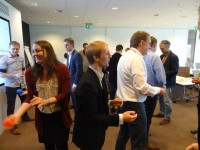Danone Nutricia Research has developed an accelerated program, ‘the Acceleration-week’, through which the development time of new products and ingredients can be drastically shortened. The starting point was ICT’s Scrum methodology used, for example, at Bol.com. In 2014, with John Mensink as a driving force, this method was further developed into a program suitable for Danone. The Acceleration Week program focuses on one project, face-to-face collaboration of the entire team and Scrum. Three pilot projects have demonstrated that completion times were up to twelve times faster. These pilot projects were conducted under supervision of Frismakers.
In recent months, this approach led by Scrum master Minke Buizer (working for Frismakers and Scrum Company) has been further refined into Organization Scrum. This article provides an exclusive behind the scenes look of Danone Nutricia Research.
Corporate hierarchy
Scrum in its purest form, removes hierarchical control. It is a time management method where issues are identified and tackled during daily scrum meetings using a Sprint backlog. Doing away of comprehensive Excel documents that control the complete implementation process is for an organization that has its roots in a hierarchical corporate culture is not always easy. Therefore, within current acceleration weeks, a balance has been found with more traditional project management approaches that overlook a longer period and a more Agile way if working. Buizer: “It has to be practical. We have planned the program for the Acceleration-week day by day, to fit the calendars of the Business Unit managers from all over the world. Most important is that the team experiences as much space as possible so they can make optimal use of their own knowledge and skills. The result is a self-managing team that addresses issues in short cycles”.
The iceberg
The acceleration program, developed in co-operation with Danone Nutricia Research, consists of a Preparation Day (P-day) and an Acceleration-week (A-week). During P-day it is determined whether all necessary expertise is represented within the team. Besides the various disciplines involved a Product Owner, a Project Manager and a Scrum Master must be appointed. The Global Strategy and Insights Manager, acts as the Product Owner. During P-day, he assists in formulating a clear and concise Product Vision.
Previously, only User-stories consisting of 20 bullet-points were used. Buizer: “I see a concise Product vision as the tip of the iceberg representing the core values of the project. The part that is hidden beneath the surface has not yet been defined. Shared insights provide sufficient direction to subsequent implementations relying on expertise, common sense and creativity of the people involved in the process”.
After the Preparation-day the team starts with the implementation of Sprint-0 as a first step for the Acceleration-week. Then the entire team of twenty people will work face-to-face on the execution. Ideally Scrum teams are more compact and consist on average of seven people. But a strict Scrum approach in combination with one-day sprints proves to be an effective approach. The focal point of all activities is the Backlog drawn up at the start by the whole team.
Scrum dreams
Buizer: “In an ideal world, not the board, but self-managing teams should determine the rhythm of a project. Over the past 1.5 years I’ve seen within Danone that face-to-face collaboration within a project brings a lot of energy and fun. Many people are used to work on multiple high priority projects simultaneously. I would like to create ideal circumstances to shorten the time-to market for a product. Working as an individual simultaneously on a maximum of five projects would be a good target.
Buizer continues: “I’d love to complete a full project according to the Scrum methodology with the pioneers within Danone and work with a compact dedicated team of 7 people. No traditional meetings, just sprint meetings and work sessions. In preparation of the go-no-go moments in the project implementation we organize an Acceleration-week so that we can make great strides face-to-face. The prognosis is that we will reduce the completion time of 5 years by about 1 to 2 years. And perhaps even more importantly, it leads to more job satisfaction through fewer multi-tasking, less mailing and fewer meetings”.
